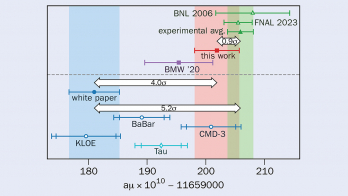by Bryce DeWitt, Oxford University Press (vols I and II). Hardback ISBN 0198510934, £115 ($230).
It is difficult to describe or even summarize the huge amount of information contained in this two-volume set. Quantum field theory (QFT) is the more basic language to express the fundamental laws of nature. It is a difficult language to learn, not only because of its technical intricacies but also because it contains so many conceptual riddles, even more so when the theory is considered in the presence of a gravitational background. The applied field theory techniques to be used in concrete computations of cross-sections and decay rates are scarce in this book, probably because they are adequately explained in many other texts. The driving force of these volumes is to provide, from the beginning, a manifestly relativistic invariant construction of QFT.
Early in the book we come across objects such as Jacobi fields, Peierls brackets (as a replacement of Poisson brackets), the measurement problem, Schwinger’s variational principle and the Feynman path integral, which form the basis of many things to come. One advantage of the global approach is that it can be formulated in the presence of gravitational fields. There are various loose ends in regular expositions of QFT that are clearly tied in the book, and one can find plenty of jewels throughout: for instance a thorough analysis of the measurement problem in quantum mechanics and QFT, something that is hard to find elsewhere. The treatment of symmetries is rather unique. DeWitt introduces local (gauge) symmetries early on; global symmetries follow at the end as a residue or bonus. This is a very modern point of view that is spelt out fully in the book. In the Standard Model, for example, the global symmetry (B-L, baryon minus lepton number) appears only after we consider the most general renormalizable Lagrangian consistent with the underlying gauge symmetries. In most modern approaches to the unification of fundamental forces, global symmetries are quite accidental. String theory is an extreme example where all symmetries are related to gauge symmetries.
There are many difficult and elaborate technical areas of QFT that are very well explained in the book, such as heat kernel expansions, quantization of gauge theories, quantization in the presence of gravity and so on. There are also some conceptually difficult and profound questions that DeWitt addresses head on with authority and clarity, including the measurement problem mentioned previously and the Everett interpretation of quantum mechanics and its implications in quantum cosmology. There is also a cogent and impressive study of QFT in the presence of black holes, their Hawking emission, the final-state problem for quantum black holes and a long etcetera.
The book’s presentation is very impressive. Conceptual problems are elegantly exhibited and there is an inner coherent logic of exposition that could only come from someone who had long and deeply reflected on the subject, and made important contributions to it. It should be said, however, that the book is not for the faint hearted. The level is consistently high throughout its 1042 pages. Nonetheless it does provide a deep, uncompromising review of the subject, with both its bright and dark sides clearly exposed. One can read towards the end of the preface: “The book is in no sense a reference book in quantum field theory and its applications to particle physics…”. I agree with the second statement but strongly disagree with the first.









